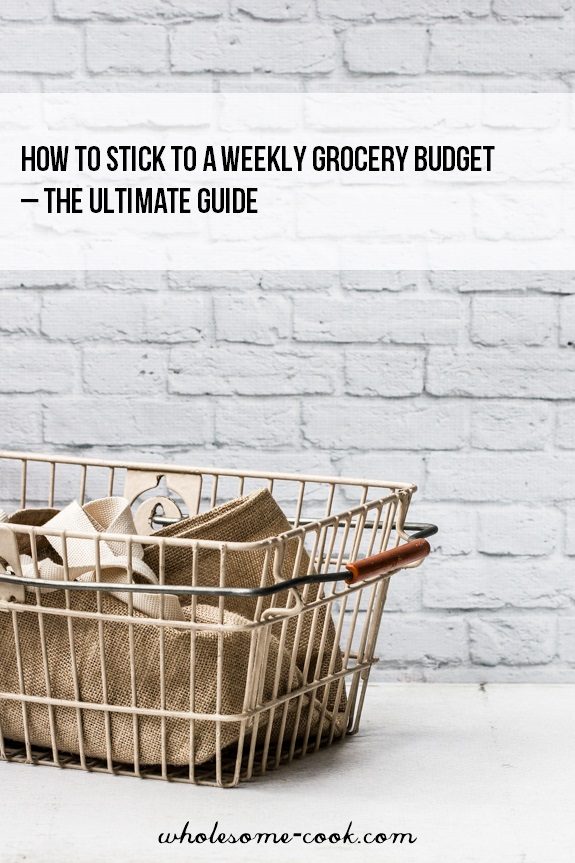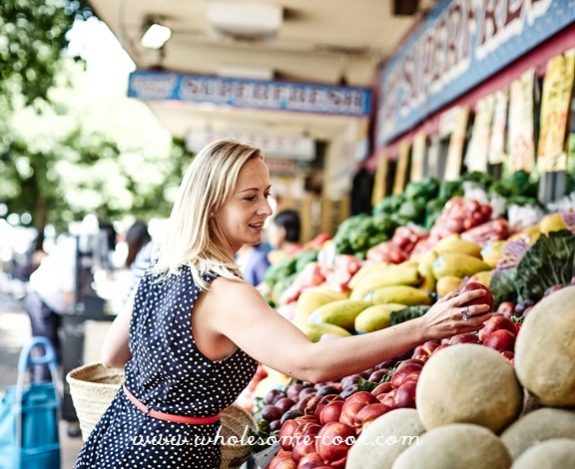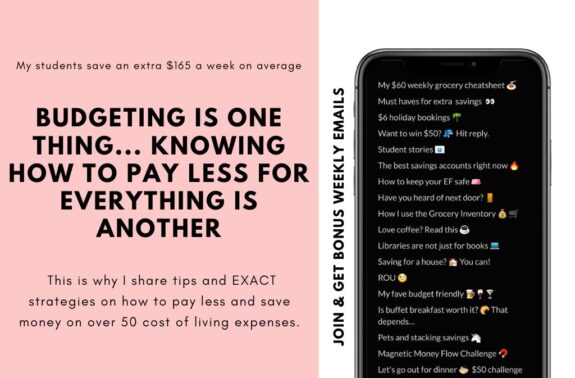[Updated] What would you do with an extra $50, $100, $200 a week? Read my ultimate guide to setting and sticking to a weekly grocery budget, that is fun and ACTUALLY works, whilst still enjoying delicious food! Full of easy to follow budgeting tips. Then join me for the weekly #120dollargrocerychallenge

It doesn’t matter if you are single, a couple or a big family. Anyone can start using these simple tips today and save money on groceries while reducing the amount of fresh food waste.
Over the past month, I have been trying to spend less a week on groceries while feeding the family three wholesome nutritious meals every day. From what I have learnt, $120 a week can go a long way for a small family ($100 for a family of 5) even when buying a few organic things and sourdough! I did allow for 1-2 meals to be eaten out during each week. But even then we ended up sharing a $10 happy hour pizza. Being frugal seems to be contagious!
How to stick to a weekly grocery budget – The Ultimate Guide
We all know how easy it is to whip out that card and lose control of your spending. Tap, tap, tap. We keep telling ourselves that the small amounts don’t matter, but they do. Hell, they do. They add up and quickly.
I was spending over $1,200 on groceries a month for just two people. Even with a budgeting app, I just kept going over with no consequence… Now I spend just $120 a week on groceries for 3 people (my Mum is visiting for 4 months). There is less food waste, more creative cooking and we are eating even more veggies.
That’s a saving of over $150 a week.
If I can do it, you can too! To get things started, read my Ultimate Guide to Keeping a Grocery Budget. The tips are designed to help reduce the weekly grocery budget!

1. FORGET THE CREDIT CARD – USE CASH
We hear it ALL the time – get rid of the credit card and use cash if you want to budget properly. Right? Unless you have a mortgage then use the credit card, keep the cash in your offset account and sweep the card monthly. So, which one is it? Confusing…
When it comes to the question of how to stick to a weekly grocery budget, it’s definitely the first one. Instead of using a credit card and tapping away at grocery stores, start using cash. It will curb overspending. And keep you accountable because what you have in your wallet is EXACTLY how much you have to spend that week. No buts. No ifs. No excuses.
Each Sunday I took out $120 and that was my weekly grocery budget. My first week’s grocery bill also included $40 worth of half-price dishwashing tabs, washing detergent and loo paper that will last for a couple of months. So, effectively I spent $80 on food. It was a revelation. It could be done! It became my thing and the most EXCITING part of the challenge.
2. TAKE STOCK OF WHAT YOU ALREADY HAVE
It’s one of the simplest grocery budgeting tips. Check your fridge, pantry and freezer for foods you may already have; pasta, rice, quinoa, canned or dried beans and legumes, canned fish, sauces, eggs, fridge and freezer veg and meat.
Make a list. Stick it to the fridge and plan a couple of meals around the foods you already have. Cross out whatever you’ve used to make the exercise easier next week.
3. MENU PLAN
Sounds boring, huh? It can be if you’re choosing to have Lasagna 52 Mondays a year. But not having a clear idea about what you’re going to cook for dinner for the week coming is probably one of the biggest contributors to blow-out budgets and extra food waste. Menu planning is key. It will help you avoid impulse buys and help you stick to a weekly grocery budget easily… Variety within your plans makes sticking to them that much easier. And more delicious.
Menu Plans are awesome – you can check out these ones here. If you ask me, definitely worth the savings that come with it.
4. GO NO FRILLS FOR MOST THINGS
It’s true! Most ‘no frills’ and supermarket brand products are manufactured by the same folks who make the branded stuff, only it’s cheaper. You can save a lot of money by buying no frills staples or even supermarket branded organic produce. Things to try include pasta, flour, dried fruit, nuts, coconut oil, butter, cheese, organic meat and veg – both fresh and frozen.
5. SHOP AROUND AND LOOK FOR OFFERS
If you’re a member of grocery store loyalty clubs, use those memberships to your advantage, not theirs. Most rewards schemes are designed to ultimately benefit retailers. But you can be smart about it.
Shop the catalogues
Look for half-price catalogue offers or coupons on non-perishable things you need or will use over the next couple of months.
These might include washing powder, dishwashing tabs, toilet paper, toiletries, coffee and tea. Only ever buy these when they are half price. You will get into a rhythm of dwindling your supplies down to one or two then keeping an eye out for the next half-price specials.
This might mean shopping at one store one week, and one of the others the next. But it’s totally worth it.
Shop seasonally
Shopping for fresh produce that’s in season means buying fruit and veg at its cheapest. Frozen veggies are also a great budget-friendly alternative when out of season, so use those to supplement your selection. The latter are also fantastic in soups.

Beware of the middle aisles
For the most part, skip the middle aisles when shopping in large supermarkets. I say for the most part because canned fish, rice, pasta, pasta sauce, herbs and spices, dried fruit and nuts, bread and the dairy aisle can still be a valuable source of budget-friendly meal inspiration and ingredients.
But, in general, that’s where you will find the most overprocessed foods that should only be considered a sometimes food and can be quite expensive. So, tread with caution and buy sparingly and on occasion.
If you do have a craving for something (I often do for a few squares – okay 10 squares – of plain milk chocolate just before that time of the month) buy the smallest packet and pick a time to enjoy it, mindfully. You might actually end up eating less of it, saving money as well another occasion.
Be smart about bonus points offers
Don’t fall for those spend $100 in one shop to get 1,000 points ($5 credit) offers. Especially when you only needed to get a few things, because you will end up filling your basket with “stuff” just to meet the spend quota. This can add to your overspending significantly! And you might find that by the end of the week you have to go back to get more things you actually need.
However, some points offers are fantastic and totally worth it, especially if there is a discount involved as well! It might be that an item is half-price but there is also a big bonus points offer attached that week. Flybuys is really great at providing you with good insights into their current bonus points promotions in one place.
I recently earned 5,000 points (equivalent to $25 off a future shop) by spending $51 on bulk health and beauty items which were 30% and 50% off and each $10 spent earnt me 1,000 points. Effectively, I was saving $25 at the checkout and $25 in points on items that would have cost $75!
Know your stores
If you’re on a budget, shopping around can save you a LOT of money. If you are lucky enough to have a number of grocery stores around you, you’ll save even more in less time! Knowing your stores and what is best priced where is really helpful with sticking to a budget.
I know for instance that I can get great value French cheese from my local Aldi any day, but when it comes to imperfect veg and “reduced due to approaching best before date” cheese, meat and veg my local Harris Farm can’t be beaten. My local Asian grocer sells fresh herbs and greens at less than half price of those found at the other stores. They also have bulk packs of organic seaweed snacks that Mijka loves.
Fall in love with those bargain corners. You will be surprised what you can find there and it’s all in almost perfect shape. How about a bundle of 5 cucumbers, 4 carrots and some chilli ALL for $1 in total! Plus the produce is not going to waste!
If your local grocer does not have a bargain corner ask them what they do with the produce. They might be happy to put it aside for you for a nominal price instead of throwing it out. It can only benefit them and you.
6. BUY REDUCED AND IMPERFECT
Become a sucker for a good bargain and extend this to the way you shop for groceries.
First up, armed with your shopping list, scour your grocer’s and supermarket in places where bargains live – corners of refrigerated sections which include dairy and non-dairy milks, meat and fish, specially designated shelves with fresh produce. Cross off your list all the reduced items and this will save you a bulk off the bill. Fish and meat can be frozen for 3-6 months even on its use-by date, if it hasn’t been previously. This will make for a good stash.
Meat
Chicken wings are perfect for broths and soups. The meat and skin can be peeled off the bone and shredded into the soup. Drumsticks can be used in the same way.
Other cuts of budget-friendly meat include chuck, gravy and shoulder cuts from lamb and beef, pork belly and hocks are easy on the hip pocket, too. Ribs are a fab addition to soups or enjoyed as part of a main. Flank steak is great for grilling. See also the next big point for saving more.
Fruit and Veg
Then there are veggies. Interestingly, the organic produce in many supermarkets gets marked down the most because it’s packaged and thus has an ‘expiry date’. LOL. Sorry. Many grocers also have a bargain area where they will put overstocked, in-season or worse-for-wear produce at rock bottom prices. Make use of those.
I have also grown fond of the less than perfect produce such as Harris Farm’s Imperfect Picks or Woolworths’ Odd Bunch fruit and veg. So nice to see it not going to waste and farmers actually getting paid for their hard work regardless of how their produce looks.
Freshest is always best so perhaps make a trip to your local farmer’s market and pick some produce from there. It will most likely be seasonal and picked fresh before the market. Your money will also be going directly to the people who grow your food. And that feels good.
7. BUY IN BULK
Okay, so this one might mean that you will go over your weekly budget sometimes (i.e. buying in bulk means more savings while spending more in one hit), but if the food is non-perishable or freezable, you will be saving money in the long run. I often do this with meat even though we don’t eat a lot of it, it saves money.
8. FREEZER IS YOUR BUDGET-FRIENDLY FRIEND
There is a lot of waste and dollars thrown in the heap when it comes to veggies as well. Freeze fennel fronds, leafy ends of celery sticks and green ends of leeks to add to soups. Use radish leaves to bulk out salads. Peel and slice broccoli stalks and add to pasta sauce, soups, salads or stir-fries. Peel and freeze sad-looking celeriac and parsnip to add to soups. Cook and mash carrots or beets to serve as a side for mains later. Beetroot leaves and stalks make for a fabulous soup.
Leftovers, divided into single-serve portions make for a quick dinner for one, take to work lunchbox or afternoon snack for hungry teens. You can also freeze diced fruit and veg for smoothies and soups. Meat, fish, seafood if it hasn’t been frozen previously freeze well, too. Butter as well!
Here is my ultimate freezer list that will help you extend your food further and save $ on your groceries.
9. MAKE IT FUN!
Sticking to a budget can actually be quite fun. Seriously! Especially toward the end of the week when you only have limited resources to shop with. It makes you become more resourceful and creative in the kitchen.
With $5 left in your wallet to spend on a Saturday you might choose to buy a big can of tuna to put on top of a salad, rather than tap and pay for $20 worth of steak to serve with the same salad. Or you might rummage through the fridge and use up the last of the zucchini along with the tuna and some olives to make a pasta sauce. You can even serve it with the same salad as a delicious side.
You might perhaps realise you don’t need to spend the last $5 on the tuna because you still have plenty of eggs and they go so well in salad! This should leave you with a $5 saving. Keep your budget savings from each week in a jar and see what they add up to over a month, a quarter or even a year!
Alternatively, getting the family to look for a treat at the end of the week is just as nice! Something like a $5 tub of ice cream for a family movie night might just be perfect!
YOUR TURN…
GOT SOMETHING TO ADD? SHARE YOUR BUDGET-FRIENDLY GROCERY TIPS IN COMMENTS BELOW



1 comment
Your article is really useful for people like me. I do few things to save my money on groceries. First I like to buy it in a bulk so I can restore the fruits and veggies and prepare the food as I feel hungry. Another thing I like to do is to recook the food. Sometimes food will not eat completely so I restore it in a freezer and use it next day but before that I cook it with few spices and herbs and it taste delicious. Well, as you say to manage meal is tough and more important to buy such things in off season. So I prefer to use online discount coupons and deals to buy my favorite food it pt saves money and also it comes at my doorstep. Mostly I used this coupons to buy food https://www.couponsmonk.com/postmates.com. I hope it will helps you too.